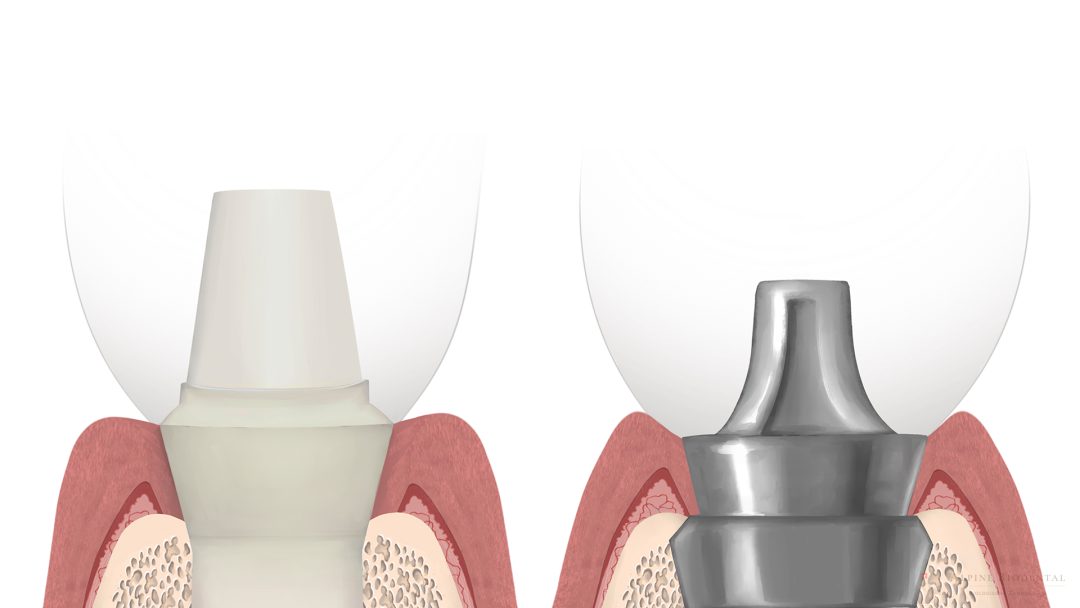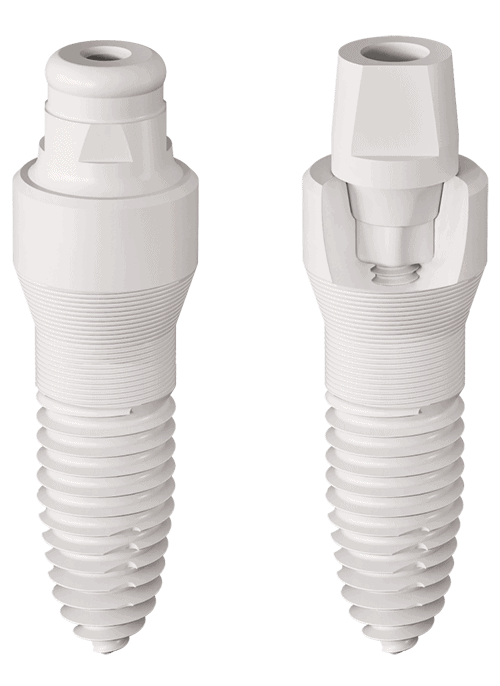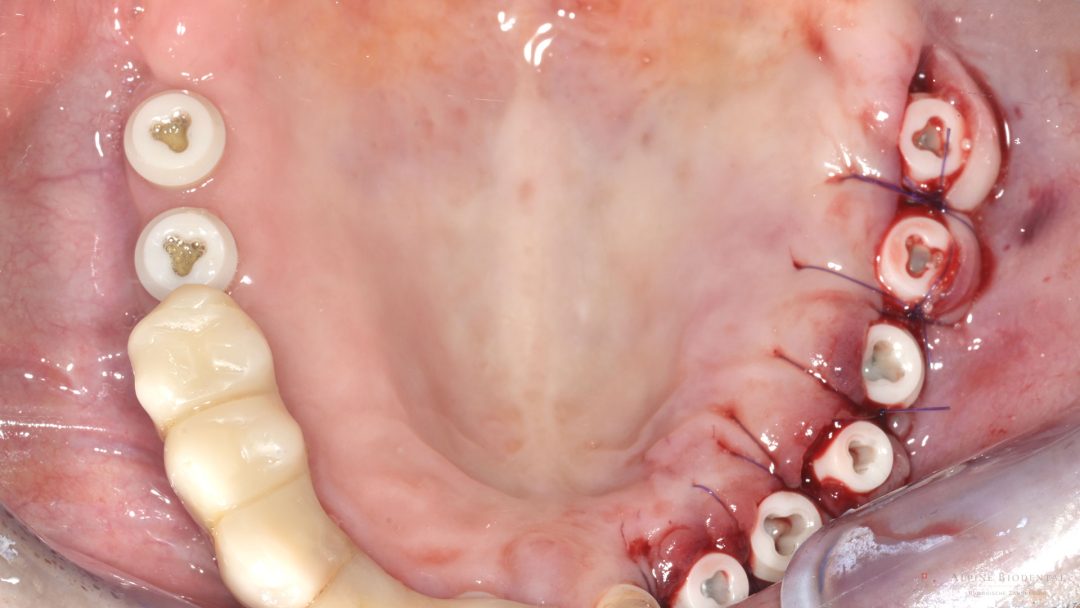Dental Implants

When a tooth needs to be extracted, whether due to chronic inflammation, decay, or an accident, many patients face the question of further care.
If the desire is for a fixed solution, dental implants offer a straightforward and highly comfortable option.
In this article, we aim to provide you with all the essential points regarding dental implants and offer you a comprehensive overview.
Definition of Dental Implants
Dental implants are an excellent way of replacing missing teeth or teeth that are not worth keeping. It is a screw-shaped system made of ceramic or titanium, which is inserted into the bone and grows firmly into it. The dental implant thus replaces the root portion of a tooth.
Once it has healed, it can be used as a basis for further construction – crown restorations, bridge restorations or implant-supported prostheses on implants are conceivable.
Informally, dental implants are also referred to as implant teeth or “implant teeth,” with both terms meaning the same thing.
Advantages of Dental Implants
Dental implants offer several outstanding advantages:
- There is no need to grind down the teeth next to the gap. A bridge restoration, on the other hand, would require the adjacent teeth to be ground down.
- Each tooth bears only its own load, reducing stress on neighboring teeth.
- Long-term prognosis of adjacent teeth remains unaffected.
- Fixed restorations on implants are possible for stable support.
- Effective restoration of significant defects caused by the absence of multiple teeth.
- Bone augmentation can often be performed concurrently with surgery, minimizing the number of procedures.
- Quick restoration of aesthetics and functionality.
Disadvantages of Dental Implants
Like any procedure, dental implants may have potential drawbacks, generally kept within manageable limits. These include:
- Mild swelling may occur.
- Slight bleeding may occur.
- Mild discomfort after anesthesia subsides is possible and normal.
- Wound infection is rare but can occur.
- Physical rest and avoidance of activities like sports, heat exposure, sauna, sunbeds, and hard foods are recommended in the initial days.
- Higher costs compared to bridges or dentures.
Types of Dental Implants
There are two types of dental implants: one-piece and multi-piece implants. These are selected before the operation depending on the region, bone situation and expected load. Multi-part ceramic implants are more frequently selected for molars. Incisors, on the other hand, are preferably treated with one-piece implants.

A distinction is also made between bone-level and tissue-level implants. This distinction refers to the height in relation to the bone or gum line. We prefer tissue-level implants because they are generally easier to maintain, any excess cement can be removed cleanly and the gums grow firmly into the implant, so that there is no open seam between the implant and the gums.
Dental implant types can also be categorized according to the material. We will go into this in more detail in the next section.
Dental Implant Material
Nowadays, most dental implants are made of titanium. In our opinion, these titanium implants have decisive deficits compared to ceramic implants. This is the reason why we at Alpine BioDental only use ceramic implants.
With ceramic implants, we can provide patients with a biocompatible dental prosthesis that is both durable and aesthetically pleasing.
Dental Implant Procedure
On your journey to a fixed implant-supported restoration, several steps need consideration for a successful treatment. The following outlines the process from consultation to implant placement.

Step 1: Anamnesis and Examination
The basis for correct planning is the collection of your medical history and general health details, medication intake, existing illnesses, etc. It is also important to discuss what expectations you have of your treatment and what your individual wishes and ideas are.
During this initial examination, the intraoral condition is checked, x-rays are taken and further diagnostics are carried out if necessary. The results will be evaluated in detail and discussed with you.
Step 2: Surgery/Implantation/Potential Bone Augmentation/Extraction
The course of action is determined by the initial situation and can vary based on individual patient circumstances.
The option of immediate implant placement:
In this case, the tooth is extracted and the implant is inserted directly into the existing bone wound in the same treatment session. We like to work with immediate implants, as the bone heals very well directly after tooth extraction and the patient is spared further surgery.
Possibility of delayed implantation:
In the delayed implantation, the tooth is removed and the dental implant is only inserted after the wound and bone have completely healed. Delayed implantation is preferable if there are large jaw inflammations or cysts. In such cases, the bone must first be built up (bone augmentation) and heal completely before the dental implant is inserted. In the case of a delayed implantation, you wait approx. 4 to 16 weeks before the implant is placed.
In principle, placing an implant is not very stressful for the patient, and the procedure also takes very little time.Implant placement is generally minimally invasive and well-tolerated by patients.
Step 3: Implant Restoration
Depending on bone quality and whether bone augmentation was required, the healing time is determined, usually around 3 to 4 months. After healing, the implant is customized to the gum line, and digital impressions are taken. Our in-house dental lab promptly crafts the final crowns and/or bridges, which are then installed in a short appointment.
Congratulations! Enjoy your new, aesthetically pleasing, and functionally reliable tooth.
Frequently asked Questions about Dental Implants
Many patients imagine the pain during and after implantation to be terrible and stressful. However, the pain from a dental implant is very slight and usually only exists directly after the operation, when the anesthetic has worn off.
The personal sensation is often very individual and depends in particular on the size of the operation. The dental implant experiences of our patients show that most of them report that they were too worried and that it was not so bad.
We emphasize a minimally invasive, atraumatic procedure during the treatment process and prevent swelling and pain. Some of our patients are amazed afterwards that they felt almost nothing during and after the dental implant procedure.
If you have a pronounced fear of the dentist, the operation can also be performed under general anesthesia. This allows the dental implants to be placed while you are in a deep sleep.
You are also welcome to share your experiences with us about how you felt about your healing process after implant placement in the upper and/or lower jaw.
Symptoms of Dental Implant Rejection
In extremely rare cases, it can happen that an implant does not heal. Such a situation is colloquially referred to as dental implant rejection. The symptoms of such a rejection or inflammation around an implant are, for example, a dull pulsation in the region, a sensation of pain or a perceived mobility of the implant. This can be determined by clinical examination or by taking an X-ray.
Causes may include mechanical overload during healing, smoking or certain medications. Of course, we will examine your situation before the dental implantation and advise you in order to create optimal conditions for good, safe healing before the procedure.
On the other hand, there is delayed inflammation on implants, known as peri-implantitis, which is a chronic process and is similar to periodontitis (on teeth). The causes can be unhealthy oral flora, metal intolerance and excessive force when placing the implant. Regular check-ups and the development of healthy oral flora prevent this condition.
Dental Implant Costs
For many patients, understanding dental implant costs is crucial. The price depends on various factors:
- Does the cost estimate include the crown, or is it only for the surgical part of the treatment?
- Is it a back or front tooth implant?
- Does the implant border the sinus, requiring a sinus lift?
- Are good bone conditions present, or is bone augmentation necessary?
- Can the tooth be immediately implanted after extraction (immediate implantation), or should the tooth be extracted and a waiting period observed (delayed implantation)?
- Which implant system and material are used?
- What are the costs for the definitive restoration by the dental technician?
- What additional measures are taken to achieve an ideal result?
- In which country or region/location is the treatment performed?
These are just a few factors defining the final price of a dental implant. Therefore, providing an exact cost is challenging. A cost estimate from your trusted dentist can offer precise information.
Patients seeking cost savings should ensure that quality and the end result are not compromised. Poorly placed implants, incorrect materials, or ill-fitting crowns can lead to treatment failure and the need for further therapy.
Dr. med. dent. Tobias Steinherr M. Sc.
Implants can be made of titanium or ceramic. Our experts are here to help you.

Frequently asked Questions about Dental Implants
At this point, we’d like to address the most common questions about dental implants. Feel free to contact us anytime if you have additional questions.
The duration depends on the extent of the treatment and whether extractions or bone augmentations are necessary.
Our treatments range from 30 minutes for simple delayed implantations (without tooth extraction) to sessions lasting one or two hours, up to full-day procedures for complete upper and lower jaw restorations with extractions and bone augmentations, including immediate provisional restorations.
If you consult a general health-supporting doctor or practitioner, you can discuss this topic with them; we collaborate with colleagues. We emphasize sufficient intake of Vitamin D3 and K2, along with Omega-3 fatty acids, magnesium, and Vitamin C, which can be beneficial before and after the procedure.
We will be happy to support you in determining your ideal therapy concept.
Implants in the mouth have no expiration date. If the healing phase is successful, there is no predetermined end to the implant’s service life. Long-term success requires good oral hygiene, avoiding smoking, maintaining a healthy diet, ensuring adequate vitamin and nutrient intake, and regular check-ups (usually 1-2 times per year).
We ask you to clarify this issue with your health insurance company yourself. Each health insurance company behaves differently in this respect. However, we would like to point out that implants are not covered by Swiss basic insurance.
If the bone lacks the necessary height or width for implant placement, bone augmentation is advisable. In such cases, it’s often best to build the bone base first before implanting. Bone augmentation and implantation can sometimes be performed in a single session, optimizing stability and aesthetic results.
If your implant needs removal, the financial responsibility rests with the patient, similar to the costs associated with implantation.
Mini implants are used when the bone height is too low to use conventional implant lengths. They are one of many options and offer the possibility of dispensing with bone augmentation – however, this advantage comes at the cost of an unfavorable distribution of the chewing loads. This can be illustrated by the leverage effect – when a crown is loaded on a short implant, the forces acting on the bone are considerably stronger than is the case with longer implants. With a longer implant, the forces are distributed over a larger bone surface.
For this reason, and with the desire for an optimal, stable result in the long term, we recommend that you build up the bone and restore it with implants of regular lengths. We also like to provide our patients with fixed prostheses (instead of working with removable prostheses) for the best comfort. A stable base is essential for a secure and strong bite.
Zygoma implants are very long implants anchored far back and high in the cheekbone region. They are used to stabilize a prosthesis. Typically, four implants (All-on-4) are employed, with two placed at a steep 45° angle far back. We do not offer Zygoma implants due to the associated risk near critical facial nerves. Additionally, in case of removal, the defect is extensive and traumatic.
Further information
The information listed contains relevant topics for a better understanding.